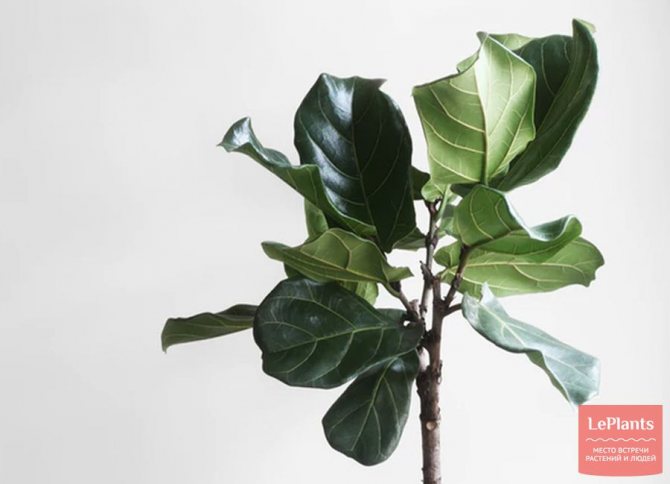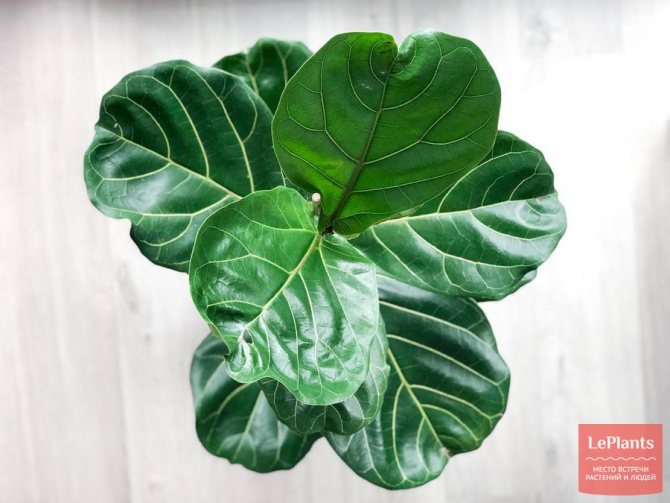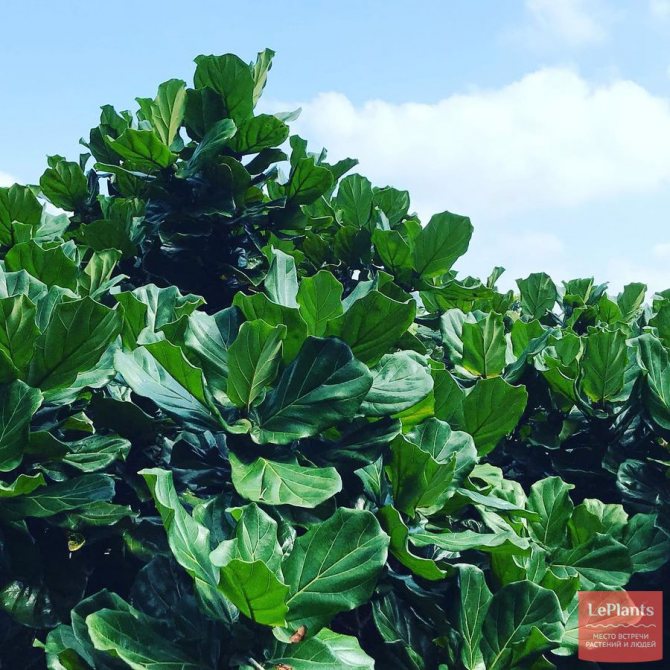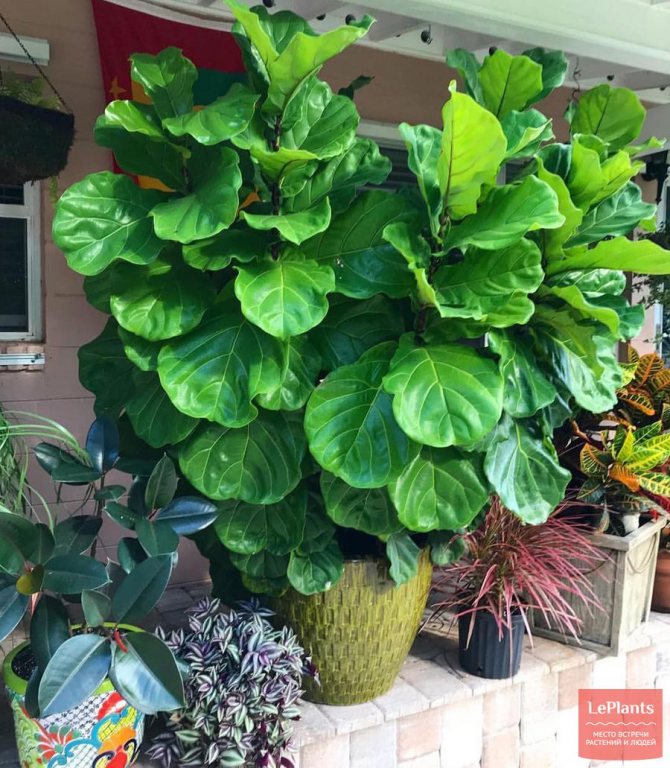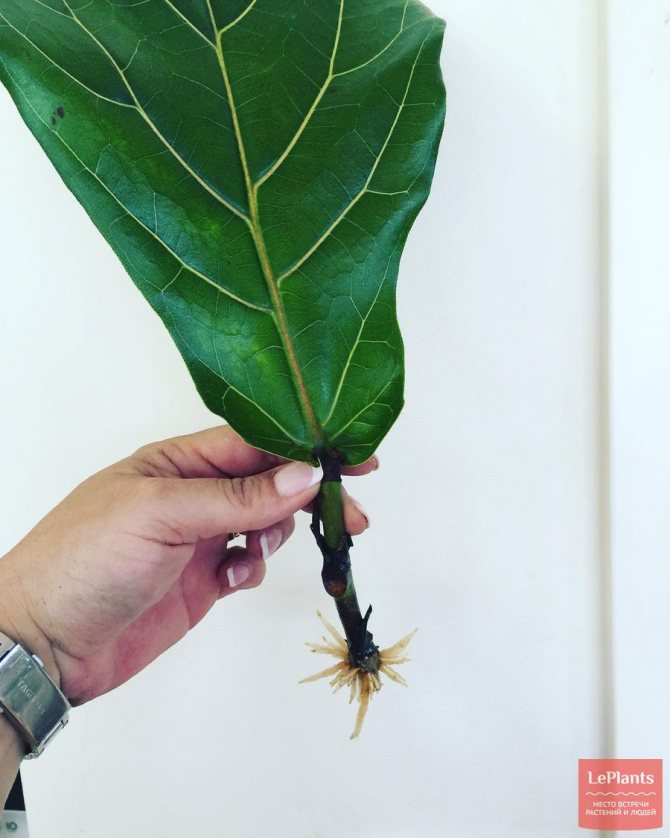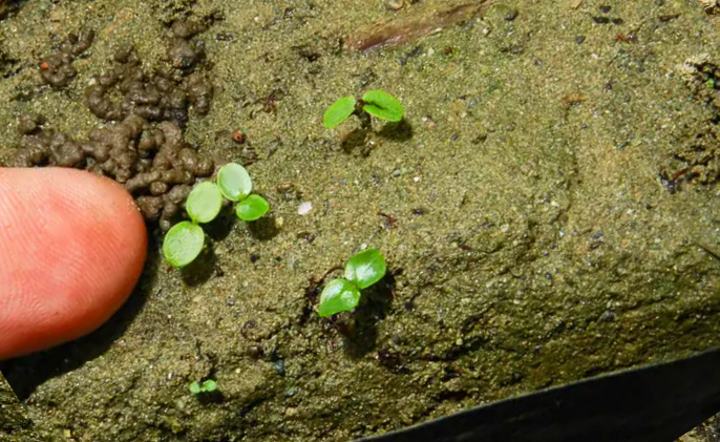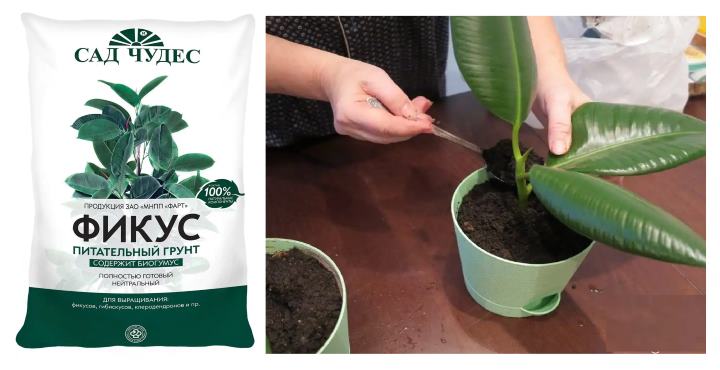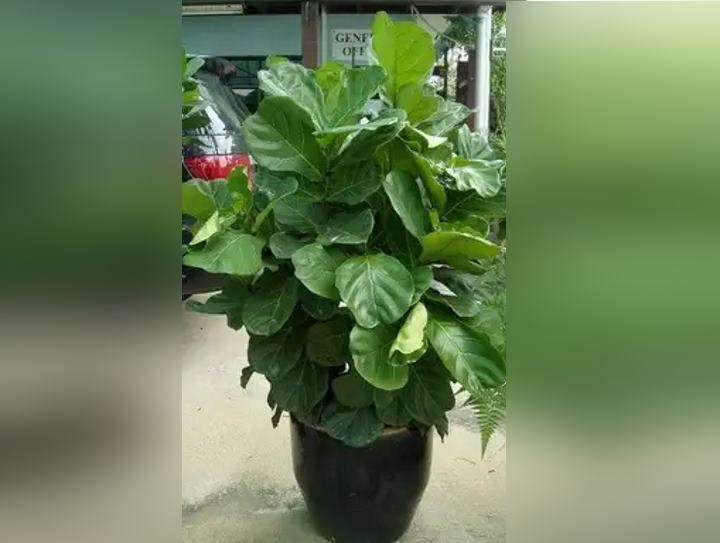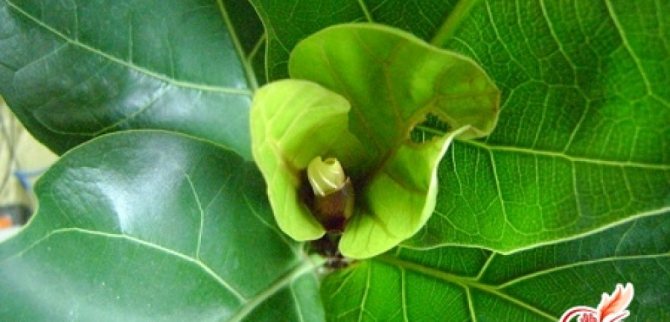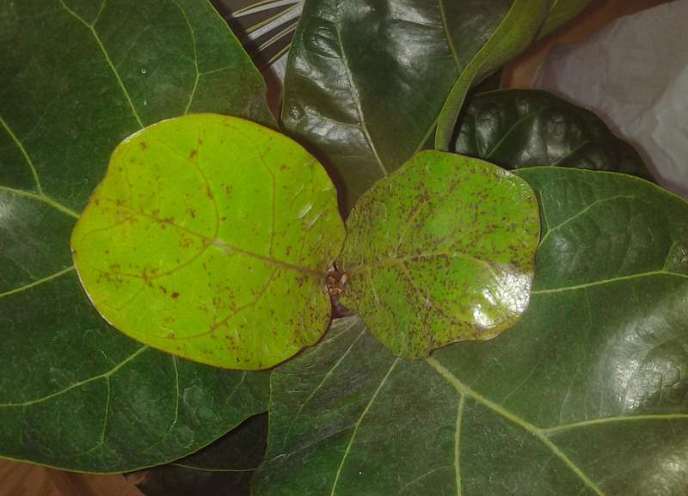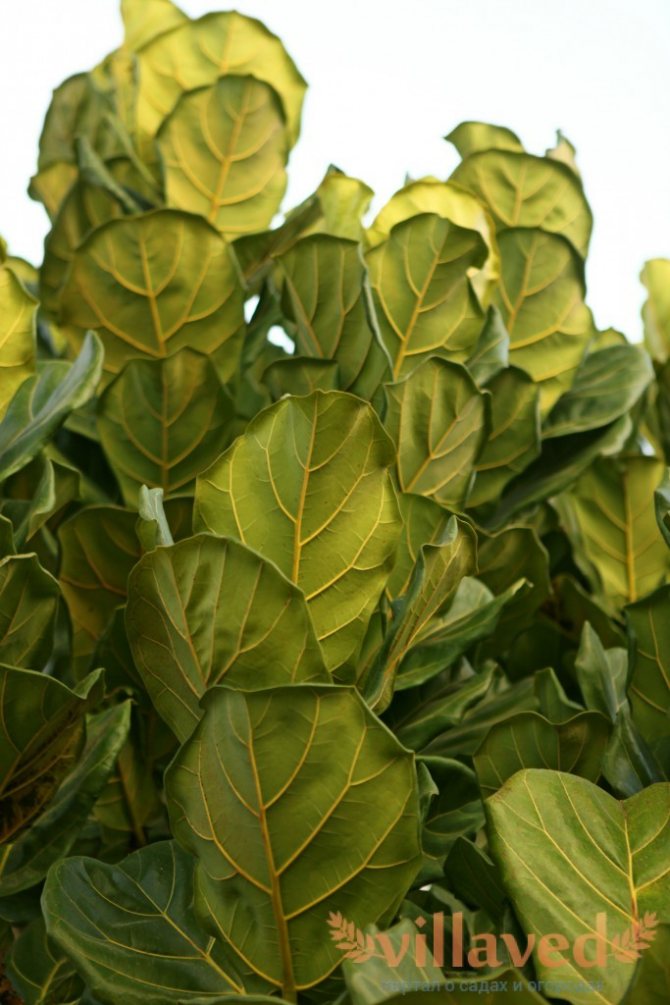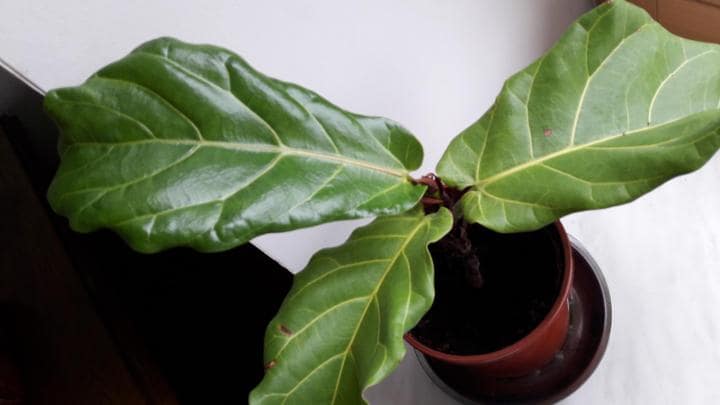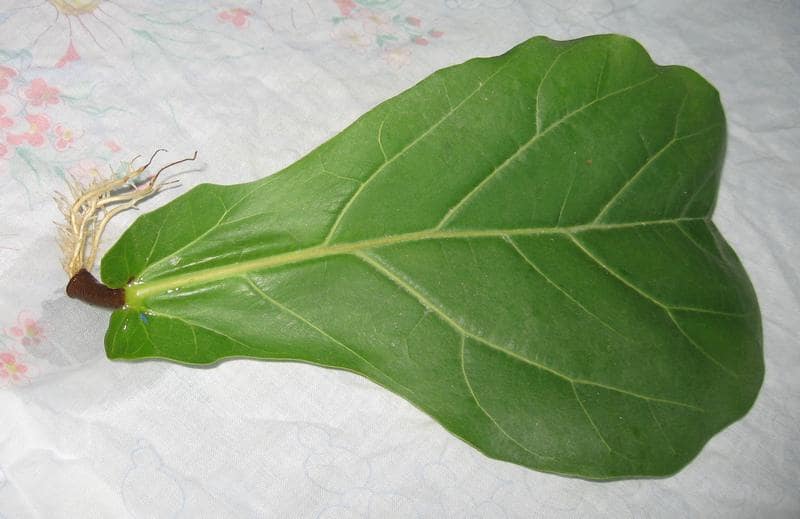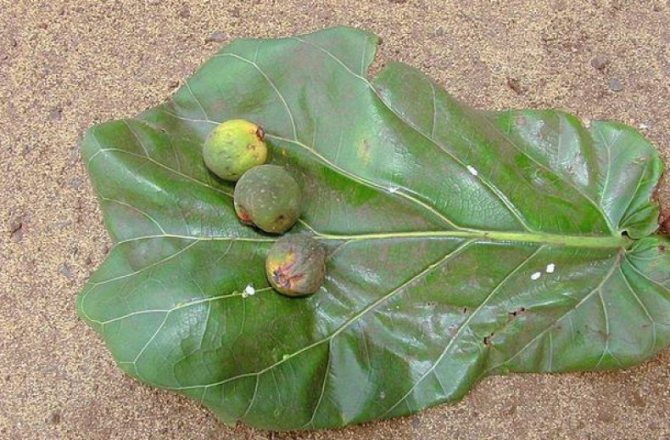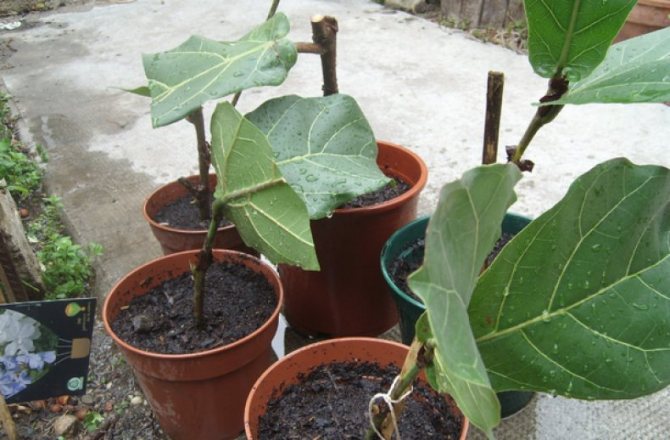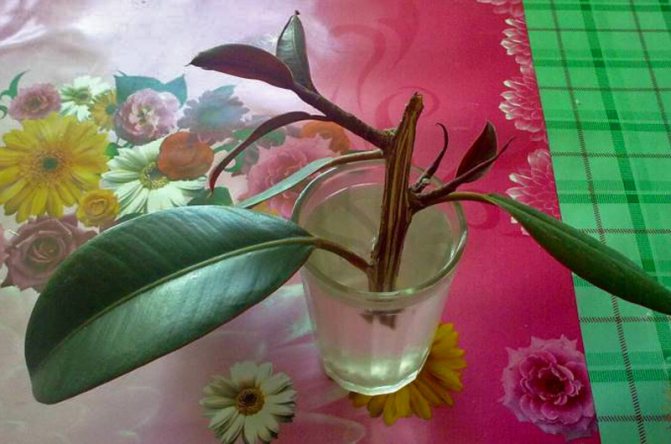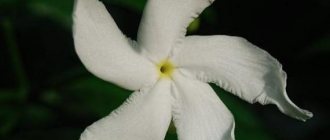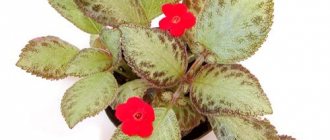Ficus: history
Ficus comes from the Mulberry family and grows mainly in the tropics. Much less often, its subspecies can be found in the temperate climatic zone. Southeast Asia is considered the homeland. It is a useful plant. Almost all ficuses are rubber plants (therefore, the second name for ficus is a rubber tree), some produce edible fruits, are used as medicinal raw materials.
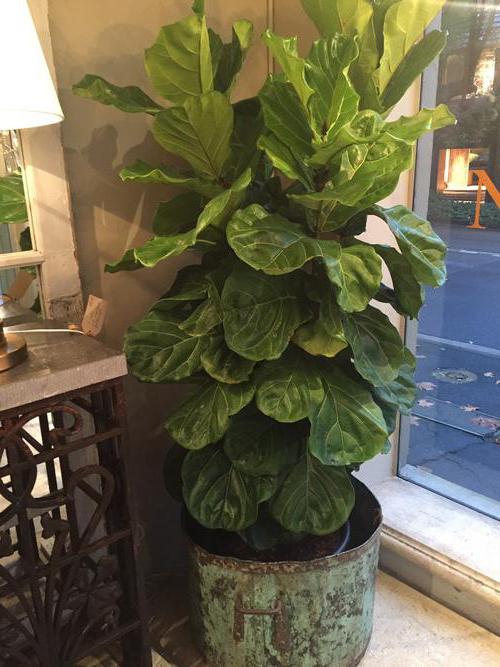
Ficus is an ancient plant that was known as far back as Ancient Egypt. It is about five thousand years old. During this time, he adapted himself to all living conditions, so it is not so difficult to maintain him. In India, ficus is called a sacred plant, often found in temples. It is believed to bestow spirituality and enlightenment.
In total, there are more than two thousand varieties of this tree.
Botanical description and characteristics of the plant
Ficus rubber or elastic ficus (lat.Ficus elastica) is a perennial plant of the Mulberry family. The thick sap of the plant contains a large amount of rubber, which is a raw material for the production of rubber. Thanks to this, the species got its name. The plant was once cultivated on an industrial scale. The juice helps the ficus in "self-healing": cuts and wounds heal quickly.
Under natural conditions, rubber ficus is widespread in the tropical forests of northeastern India and southern Indonesia. The appearance of the ficus growing in the homeland differs significantly from the indoor one. So, wild ficus is capable of reaching a height of 30-60 meters. As it grows, a single-stemmed tree develops branches. Aerial roots are formed on their surface, which take root, reaching the soil surface. This life form of the plant is called banyan tree.
Features of the
This is an evergreen ornamental plant. Its name comes from the Latin lyratus - "lyre". It got this name due to the fact that its leaves resemble a lyre or violin in shape. For the same reason, it is also called a ficus violin.
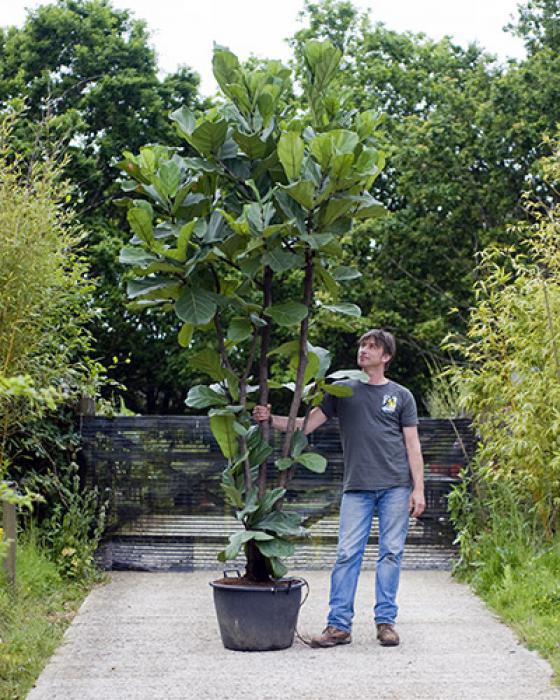

Africa is considered the homeland of this species. In nature, it reaches as much as twelve meters (how big it can be, you can see in the photo - the lyre-shaped ficus is several times larger than a person's height!) And therefore has every right to be called a tree. It is found mainly on forest edges. In the depths of forests, it often grows not independently, but as an epiphyte (that is, it is located on other trees). This ficus differs from other species in its love of loneliness, it needs a separate space without neighbors. Does not tolerate being disturbed. It is not rubbery.
Lyre ficus can be successfully grown both at home and in the workroom.
Benefit and harm
When in contact with the plant, it is advisable to use protective gloves. Ficus juice can cause an allergic reaction.
Attention:
ficus "Lirata" is contraindicated in the house for people suffering from bronchial asthma.
Still, this tree-like plant is more beneficial than harmful.
Many medicines and ointments are made on the basis of ficus juice. They are used to treat female diseases. They also treat hemorrhoids, sciatica, osteochondrosis, arthritis.
Scientific name
Ficus "Lirata" has a scientific name - Ficus lyrata.
It is increasingly found in homes, becoming a decoration of offices.
Appearance
In captivity, lyre ficus grows to a maximum of two and a half meters. The tree has a straight, rough trunk with brown-gray bark, which is covered with leaves - wavy, large (up to 50 centimeters in length), dark green, with lighter veins. You cannot cut them off. The lyre ficus is larger than its comrades. Its flowers are not very beautiful, and the large fruits, unlike the fruits of some other species, are inedible, green in color. It is quite problematic to achieve flowering of this plant.
How to propagate rubber ficus
Reproduction of ficus Elastic (rubbery) begins with the choice of breeding method. This plant is quite adaptive, so there are many methods for creating a seedling. The most popular among them:
- Propagation by cuttings.
- Breeding with air layers.
- Using sheets.
The rules for breeding in each of the above methods are fundamentally different. Only with strict adherence to the correctly selected instructions can the desired result be achieved.
Propagation by cuttings
The fastest and easiest way to propagate rubber ficus is to separate the stalk. In this case, the plant is exposed to great stress, but if care is not neglected, then diseases and shedding of leaves can be avoided. This procedure is carried out in the spring.
Cutting begins with the selection of a branch for separation. For this purpose, it is best to use young shoots. Old, hardened branches are more difficult to separate and take longer to form a root system. The ideal stalk will be about 15-16 centimeters long.
After separating the branch (always at an angle), the cut site does not need to be processed. Ficus secretes a natural healing sap that helps the plant cope with loss. The main thing during this period is to water the mother flower abundantly immediately after the cuttings procedure and not leave it in direct sunlight.
All leaves are removed before starting the procedure for forming the root system. This is necessary so that the cutting does not waste its vitality to maintain them. If the leaves are removed, the roots form much faster and the risk of infection of the future seedling is greatly reduced.
After separation, the stalk is immersed in water. Some gardeners recommend covering the scion with plastic in order to create a mini greenhouse. This method only works with not too young cuttings. If the tip of the appendix has not yet been covered with a hard bark, then it is better not to risk it, because condensation can lead to rotting.
After about 2-5 weeks (depending on the health of the cutting and the conditions created), the first roots will appear. It is possible to plant a seedling in the ground only after the first small leaves have formed. The air in the room all this time should not fall below +20.
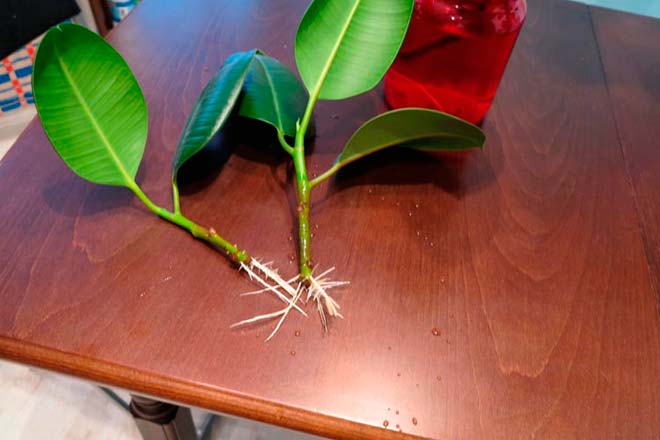

A shoot with a leaf
Leaf breeding is a less stressful way for the plant to create a seedling. At the same time, this method requires more time, and young plants do not always root well in the ground.
Leaf breeding involves the separation of not only the leaf itself (as, for example, in violets), but also part of the stem. You need to measure the size by the internode. A branch is cut right next to it at an angle.
It will be possible to root such a shoot only in a well-lit place. You need to put the leaf in the water for a short time, and then it dries out under the indirect rays of the sun during the day. After the appearance of the first small roots, the future ficus can be planted in a separate soil. In this case, the leaf must be rolled up and fixed with a thread in the shape of a tube so that it serves as a "shape" for the future stem and the ficus grows upwards, and not in breadth.
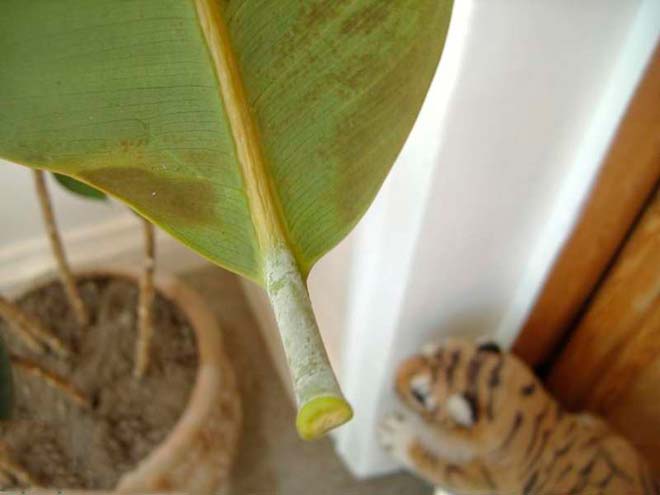

Air layering
Creating a seedling with air layers is one of the most unusual ways to propagate ficus. It consists of several steps that must be followed exactly with the instructions.
First of all, a shoot is selected for the formation of layering. It should be a long branch that is already hard-skinned, but not one of the central ones. All leaves are cut off from it in the place of formation of the layer, so that they do not interfere with the formation of the future ficus.
Lyre ficus: home care
This type of ficus is somewhat more capricious than others. Taking care of it is more difficult, and if conditions are not suitable, Fikus lyrata will begin to shed its leaves. It is best to buy it in the warm season, in spring or summer.
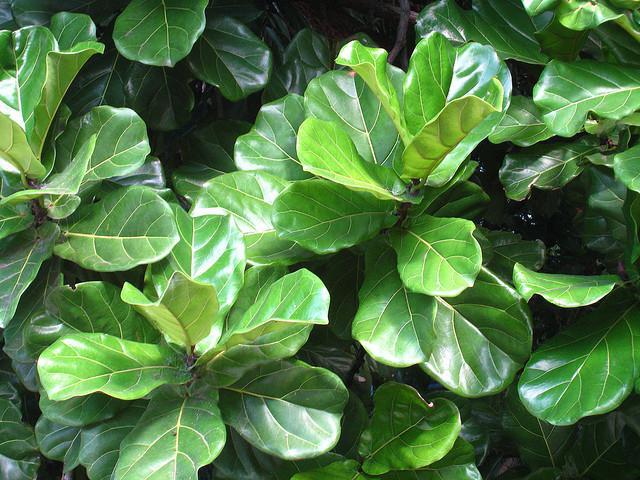

The most important thing to remember: all ficuses, including lyre, are photophilous. In nature, they fight for a "place in the sun", so in captivity you need to carefully consider where the plant will be located. His residence should be well lit, but at the same time protected from direct sunlight. On winter evenings, lyre ficus will not refuse additional illumination.
The most ideal location is the western and eastern sides of the apartment. If you place a pot of ficus from the south, then you need to do this at a distance from the window. Particular attention should be paid to the fact that if there is not enough light for the plant, the leaves will fall off and the roots will elongate, the tree will stop growing. As mentioned above, the ficus does not like its neighbors, so there should not be any other plants next to it.
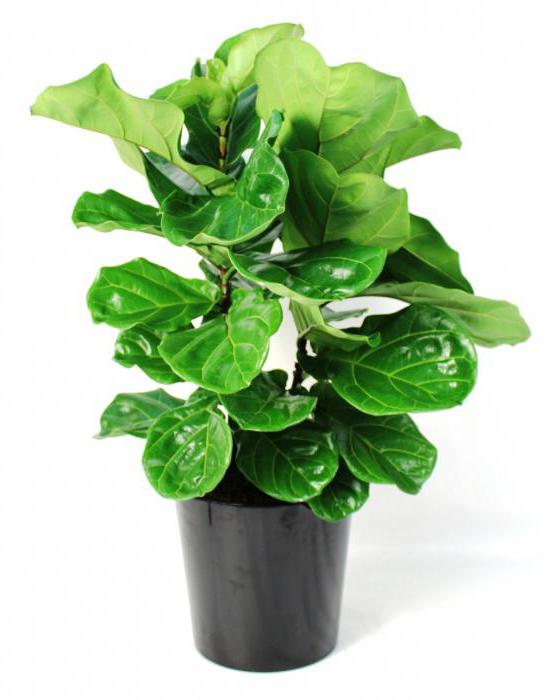

You cannot put the pot directly on a cold floor, on a windowsill. In no case should the tree be overcooled, and drafts should be avoided. Lyrate ficus is thermophilic, so the optimal temperature for it is at least twenty degrees above zero (in the cold season, a decrease to fifteen degrees is permissible). Reacts very painfully to temperature changes, to such an extent that dark spots can form on the leaves. The room where the plant stands must be systematically ventilated.
Caring for the lyre ficus involves periodically spraying the plant and wiping its leaves with a cloth, since he is quite sensitive to the issue of air humidity. If the ficus is too rich in leaves, you can proceed as follows: cover the soil tightly with plastic and simply wash the plant. The water that is used to wipe and spray the tree must be clean, separated and at room temperature - in no case cold, without any impurities. To increase humidity, you can also use a container of water located near the ficus tree, or a humidifier.
Lighting and temperature
Expert opinion
Ivan Kuznetsov
Farmer
I would like to advise you homemade oyster mushroom mycelium - the first harvest in 10 days, it grows at any time of the year for free - want to try it?
To learn more
Comfortable conditions for keeping lyre ficus are the key to obtaining a healthy and strong plant. The flower grows in the tropics, so high humidity and high temperatures should be observed. Lyre ficus is a light-loving plant. The corresponding location will be on the east side of the house. It is recommended to put the flower next to the window, but at the peak of solar activity, the ficus should be shaded so that the leaves do not get burned. In case of insufficient lighting, the ficus lyrata will slow down in growth, and the trunk will begin to stretch towards the light source.
The suitable temperature in the summer season is around 23-26 degrees, in winter the temperature is lowered to 17-20. Sudden changes in temperature will adversely affect the plant. Ficus can shed all the leaves. Overcooling of the soil is also unacceptable. If you put the ficus on the window, then there should be no drafts.
Pruning lyre ficus
An indispensable condition for the normal existence of a tree is its pruning. This is done so that the crown develops correctly in the plant, it is thick and branched.When removing extra shoots, the lower buds are activated, which previously "slept", but now they begin to grow.
The formation of a lyre ficus is done once every two to three years, more often it is not necessary. You can cut off not only the branches, but also the trunk when it reaches its maximum size. It must be remembered that the cut is made diagonally on the trunk, and straight on the branches. You can wield both scissors and pruners, the main thing is that the tool is disinfected.


An important point: it is necessary to perform the crown formation procedure very carefully. Ficus secretes a white sap that irritates the skin. Therefore, it is best to work with gloves. If the juice gets on the leaves, they must be wiped off immediately.
Pruning and shaping the crown
One of the main properties inherent in ficuses is their rapid growth. If you want to propagate or shorten the flower, you will have to cut off the young shoots. By this action, you will solve two problems: crown formation and plant rejuvenation. You need to cut it a few centimeters above the internode.
The cut provokes the development of new buds, and the plant will begin to branch. In order for the crown to develop evenly, remove branches along the entire height of the plant. The more young shoots you cut, the thicker the ficus will be afterwards. Be careful: the juice produced by cutting is very harmful to the skin. And the sheet plates must be cleaned of it.
Transplant and feeding
The plant likes mineral fertilizers. You can feed him with them once every two weeks during warm seasons. Any mixture for indoor flowers will work, but it is best to give the ficus a dose less than what is recommended in the instructions. In the cold season, you do not need to feed the tree. It is also permissible to alternate mineral and organic fertilizers.
It is advised to replant the plant in early spring. If it is young, this must be done annually, if it is an adult (a tree is considered to be more than four years old) - in the event that its roots no longer enter the pot. The new capacity should not be much larger than the previous one. You shouldn't buy a pot that is twice the size of the old one.


The most ideal soil for lyre ficus is a combination of peat, perlite and sand. Soil of peat, sand and leafy earth is also suitable. You can either add the desired mixture yourself or buy a ready-made substrate in the store. Adult plants require a denser soil than young plants, so humus or sod may be added to them. Bone meal is also placed in the ground. At the bottom of the pot, there must be drainage, as a rule, from charcoal, expanded clay, broken brick.
Before replanting the plant, it should be well watered - then it will easily part with the old "house". Carefully, so that the roots do not inadvertently suffer, the ficus must be taken out and thrown into a new pot. Then you can add the previously prepared land.
The main reasons for flying around the leaves of rubbery ficus
The content of rubber-bearing ficus (another name is elastica) in the room can be called trouble-free. The plant looks more powerful, leathery leaves look like a strong chitinous robe. From time to time, flower growers notice that he has leaf fall and caring owners have a question: "What to do?"
The question is off topic ... The question is about summer cottages
We are constantly receiving letters in which amateur gardeners are worried that due to the cold summer this year there is a poor harvest of potatoes, tomatoes, cucumbers, and other vegetables. Last year we published TIPS on this matter. But unfortunately, many did not listen, but some still applied. Here is a report from our reader, we want to advise, which will help increase the yield up to 50-70%.
We advise you to prepare in advance for the summer season, pay attention to this biological product. A lot of positive feedback
Plant care mistakes: irreparable consequences
The reasons for elastics to fall off are similar to those described above. The difference between them lies in the requirements for illumination; direct sunlight is unacceptable for the rubber. They grow best in diffused sunlight. And specimens of the Robusta variety, which have a dark green color of the leaves, feel great in a less illuminated place in the room.
Ficuses with variegated streaks and light edging of leaves have an increased craving for light. Such plants react by falling foliage to a lack of lighting, therefore, they need to pick up a bright area, but without the possibility of sunlight, in order to avoid their burns.
The main reason for the leaf fall of these species is the wrong soil moisture regime. Too frequent watering, aggravated by low water temperatures, negatively affects the well-being of the plant. Recently, flower growers often use hydrogel for decorative purposes on the soil surface in flower pots. It should be borne in mind that this method of decorating the composition is suitable only for moisture-loving varieties, because the hydrogel delays the evaporation of moisture from the soil surface, prevents air exchange of the roots.
Ficuses, on the other hand, like loose, light, well-drained soil. Stagnation of water is unacceptable for them. Excessive moistening of the earth can be indicated by the appearance of midges, green bloom on the upper layer of the soil, heavy loosening. If such a phenomenon is detected, you should take a break in watering until the clod of earth is completely dry and then begin to water moderately. The condition of the green pet should return to normal.
Indoor plant fall: yellow foliage
Reproduction
It is important to remember some of the features of ficus reproduction:
- This can only be done in spring or early summer.
- After cutting the cutting, it is necessary to rinse the cut with water, since the juice will flow from there. Then you need to give time to the wound to heal, leaving the stem in the fresh air for several hours.
- Only lignified shoots can be cut off, since the young ones will not yet take root.
Reproduction of lyre ficus occurs by cuttings. They are removed strictly at an angle, armed with a very sharply sharpened knife (not pruning shears!) It is not recommended to cut short shoots, the optimal length is ten centimeters. The bottommost sheet must be removed.
When the cutting is already dry (after rinsing), it must be placed in water. Activated carbon is added there (one tablet). If the leaves on the appendix touch the water, they need to be cut off - otherwise it will simply rot and everything will go down the drain. The cutting will begin to take root in about a month. If you create a "greenhouse effect" (wrap with polyethylene, heat up), the process can be accelerated. When the shoots release the roots, you can safely transplant them into small pots with a suitable soil substrate.
Loss of leaves in ampelous species
Ficuses of ampelous species do not tolerate overdrying of the earth; climbing plants respond to it with yellowing of leaves and falling off. In summer, it is advisable to place containers with these flowers on pallets with wet fillers - expanded clay, hydrogel, small pebbles. And in the winter months, with a reduction in total irrigation, ampelous bushes are sprayed with water from a spray bottle.
Withering houseplant
The healthy existence of indoor dwellers is undermined by frequent transplants, after which the death of green organs is very often observed. Transplants of tree-like ficuses should be done in the spring about once every two years. It is impractical to touch large specimens in large containers; only surface soil is replaced for them.Ampel bushes do not like replacing habitats even more. They are moved to new pots every four years.
Diseases and pests
The main disease of lyre ficus is considered to be a fungus. It is characterized by the appearance of dark spots and dots on the leaves of the plant. Special chemical preparations help to fight fungal infections, but it is best not to bring to this, but to ensure the prevention of the disease - with appropriate humidity and temperature conditions, the ficus fungus will not touch.
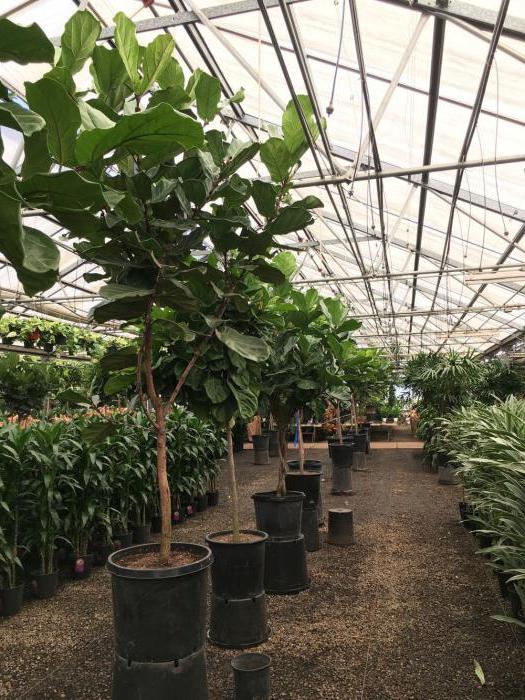

The tree also suffers from spider mites. The leaves turn yellow, specks are poured on them. You can also prevent this by simply maintaining sufficient humidity in the room with the tree. In addition, it is permissible to periodically treat the plant with special solutions. Another infection - mealybug - is eliminated with alcohol. You just need to wipe the ficus with a swab dipped in it.
Ficus leaves may also turn yellow due to changes in temperature, low light, and too wet soil. All this must be constantly monitored.
Possible problems
Treble ficus can be affected by fungal infections and pests. In addition, problems are possible if the rules of care are violated. So, for example, with excessive watering, its leaves may begin to turn yellow and fall off. The reason for this trouble is also sudden temperature changes and insufficient air humidity.
With fungal diseases, brown specks and black spots appear on the leaves. Treat such infections with fungicides according to the instructions on the package. The most common pests affecting the violin ficus are ticks and mealybugs. The plant is treated with acaricides for the tick, and the mealybug is first removed with a cotton swab soaked in an alcohol solution, and then the plant is treated with any anti-coccid drug.
Is it possible to keep ficus at home
It would seem that ficus is a wonderful plant that is not only very beautiful, but also capable of purifying the air. Of course, you need to breed it! However, there are many different signs. So, some believe that ficus contributes to the development of vices - envy, jealousy. Slavic beliefs said that in a house where there is a ficus, there is no love. Ficus is also called undesirable for single ladies - supposedly it drives away possible gentlemen.
But all foreigners, on the contrary, say only good things about ficus. It is considered an ideal plant for strengthening family relationships as it positively influences the atmosphere in the home. The Chinese believe that ficus gives coziness and helps in solving family problems and needs, and also clears the aura of negative influences. And ficus also helps to get pregnant, since it is the keeper of the hearth.
To start or not to start a ficus, to believe or not to believe one or another omen - everyone decides for himself. But one thing is undeniable: this is a truly spectacular plant that will delight the eye all year round.
Growing and care
Growing conditions
Ficuses love enough light. If the plant does not receive the required amount of light for a long time, the root stretches out, and the shoots become bare.
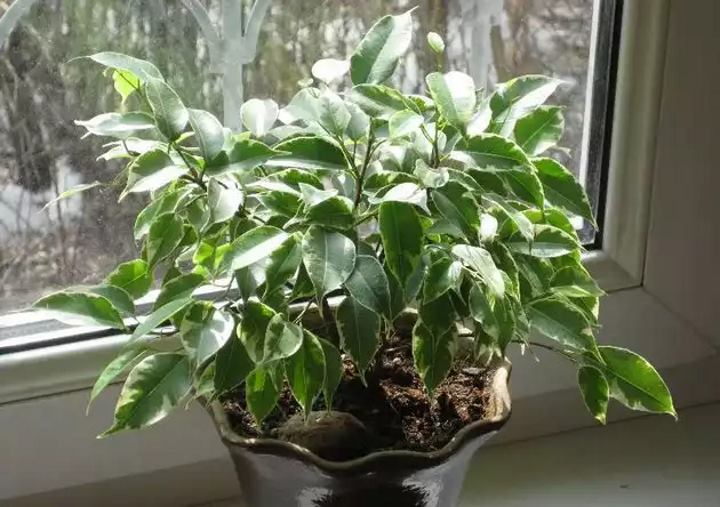

To prevent this in winter, reduce the frequency of watering. The soil should be loose and fertile. The flower shops sell the substrate for its cultivation.
You can also prepare it yourself, in equal proportions, mixed universal peat soil with turf soil, humus and sand.
Reproduction
Breeding with leaves
Leafy cuttings take root best of all.
- A plastic glass is suitable for planting, a layer of drainage and foam is laid on the bottom, holes are made to drain excess water.
- The soil should be loose, the cutting should not be planted too deep.
- For stability, you can prop it up with any stick.
- Before planting, rinse the shoots thoroughly in clean warm water.
- After planting, they are thoroughly watered and a plastic bag is put on top to create an artificial greenhouse.
- Observing all the requirements, after a month, the cutting will take root.
Propagation by apical cuttings
In the process of growing, the trunk of the ficus is strongly stretched and becomes light-leaved.
- In this case, the ficus is pruned.
- The selected stalk for planting must meet the following requirements: length about 7 cm, an area with 2-3 internodes, the cut is made under the soil itself.
- Preparing for planting: after you have made a cut, you need to rinse the cutting.
- Remove the sheet from the bottom, fold the large sheets with the outside to the inside and fix them with an elastic band.
- Then the prepared cuttings are planted in loose soil, at a slight slope. Deepen by no more than one internode, and watered thoroughly.
A greenhouse built from an ordinary package accelerates the process of root formation.
A modern means of rooting planting material are peat tablets, which give almost 100% positive results, due to the growth stimulants that are included in their composition.
Propagation by air layers
Previously, this method was used exclusively for the rejuvenation of ficus. Nowadays, this is a great way to reproduce ficus at home.
- A long, elongated shoot should be used, which is subsequently cut off.
- A vertical incision is made in the selected area.
- Insert a toothpick or wood chip into it, sprinkle with wet sawdust or moss, and wrap it with plastic wrap.
- Observing all the conditions, the first roots will appear after 45 days.
- Then the young shoot is cut off and planted in a separate container.
Landing rules
After acquisition, the ficus is transplanted into new soil. Do within 5 days.
It is preferable to choose a fertile slightly acidic substrate.
- To plant a young plant, sod, leafy soil, peat and river sand are mixed in equal proportions.
- For an adult, the amount of sod soil and humus is doubled.
In order to disinfect the soil, wood ash is mixed in.
Considering the large weight of the flower, the pot must be heavy, spacious and well-resilient. Florists often use clay containers.
Technology:
- a drainage layer is laid on the bottom and the container is filled 1/3 with a substrate;
- the plant is placed in the central part along with an earthen lump;
- voids are tamped;
- from above, the soil mixture is sprinkled with river sand.
Beneficial features


Photo of a plant in a pot
Lyre ficus will successfully fit into any interior thanks to its interesting appearance and “grooved” foliage. But in addition to its decorative qualities, the plant is valued for its ability to cleanse the air from toxic impurities, oxygenate the environment, and also create a favorable energy atmosphere in the house.
In addition, ficus is widely used for the manufacture of various medicines used in the treatment of a wide range of diseases.
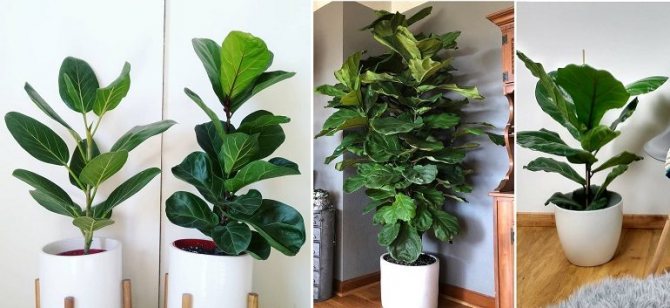

Fertilization
Ficus grows at a fast pace, and in order for it to look attractive, it is necessary to apply complex fertilizers, which include certain elements.
| Element | Description |
| Nitrogen | Provides enhanced growth and rich foliage. Urea is rich in nitrogen, which must be added once in the spring. |
| Phosphorus | Essential for the growth of the root system. This element is found in superphosphate. |
| Potassium | Maintains the required fluid level. Increases the defenses of the flower. One of the most common top dressing is wood ash. For correct application, it is diluted with hot water and insisted for a week. 1⁄2 l. boiled water is taken 1 tbsp. l. ash. |
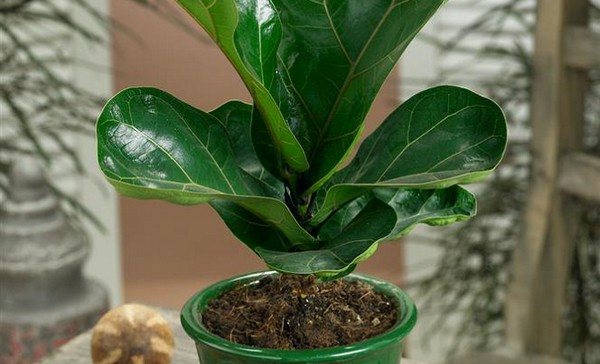

It is recommended to periodically fertilize lyre ficus
For convenience, you can use complex dressings, which are presented in a wide range in stores in both granular and liquid form.
Testimonials
The Lirata variety has gained popularity among flower growers due to its unusual foliage shape and large dimensions. Indoors it grows up to 2.5 m.
The plant is suitable for the interior of apartments, offices and public places.
It requires the creation of a favorable microclimate, is afraid of drafts, stagnation of moisture in the pot and freezing of the roots, otherwise it begins to shed leaves.
It is possible to propagate a flower in artificial conditions using cuttings and air layers; seed cultivation is not used.
Description
The homeland of the lyre ficus is the hot African continent. In the natural environment, the plant reaches 13 meters, but as a houseplant, it is much lower - on average, a lyrate grows by 2.5-3 m, and when carrying out decorative pruning, you can even get a mini-version of this unusual tree.
This unusual variegated ficus got its name due to the external resemblance to the silhouette of a lyre. Lyrata is distinguished by rather wide leaf plates with wavy edges and well-distinguishable veins of a pale green color - they stand out strongly on the common dark leaf plate. The top of the leaf plate is rounded, and the base is more narrowed, the length of the leaf of an adult plant is 40-50 cm in length and about 20-25 cm in width, the coating is glossy, shiny. In the middle, the leaves are pulled together "at the waist", due to which they take a shape reminiscent of a musical instrument.
The trunk is grayish, as a rule, the stem is straight and rough.
Advice
Since the ficus is a resident of the tropics, hot temperatures will only benefit him. The plant will feel great and develop at temperatures from +20 degrees.
Do not expose the plant to temperature extremes, otherwise dark spots may appear on the foliage.
Important! The room in which the ficus is located needs to be ventilated more often, but not allowing drafts.
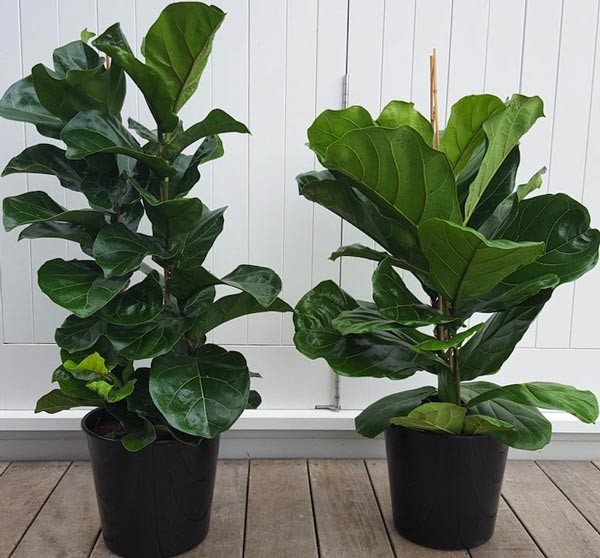

Such ficus feels good even at high temperatures.
Air humidity is not easy to maintain. This can be helped by a basin of water located near the plant, or a humidifier. However, if this is not possible, the leaves are wiped or sprayed with settled water.
How to choose?
The most common varieties of lyre ficus are multiple plants.
- Columnaris - this is a tall columnar plant, it is most often used for arranging winter gardens, greenhouses, as well as for decorating public premises.


- Little fiddle - a medium-sized shrub, very popular in offices.
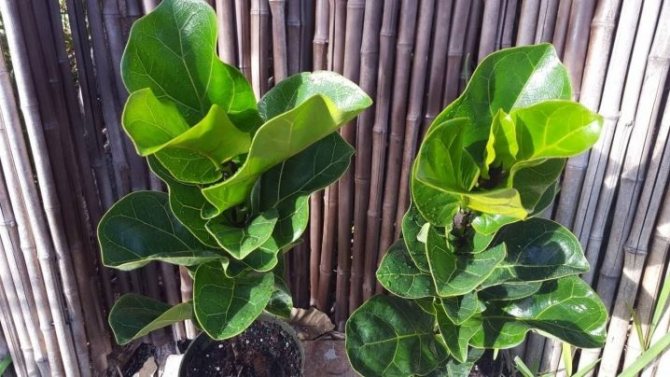

- Bambino - a short flower with a relatively small crown and rather small foliage. It is mainly purchased for home cultivation.
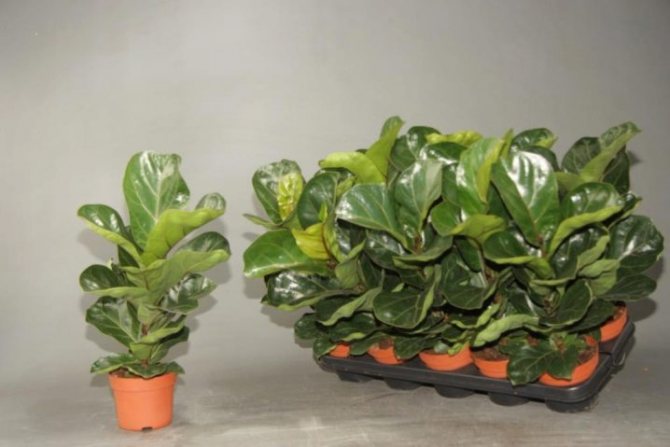

Large ficuses grow rather quickly and reach a significant height. They require a lot of space, therefore they are not suitable for decorating small apartments. In small rooms, it is worth giving preference rather compact variety "Bambino" - it takes up very little free space.


Frequent mistakes
When growing Lirata at home, growers often make a number of typical mistakes, sometimes detrimental to the health of the plant.
- When pruning, leave the top. As a result, the flower stretches in height, and the crown looks scanty.
- Ignore wet foliage rubbing. A large amount of dust accumulates on a large area of leaf plates, which becomes an obstacle to full absorption of light, inhibiting the process of photosynthesis and disrupting nutrition.
- Place in direct sun. Leaves under the sun's rays get burned not only in summer, but also in winter and begin to dry, which, together with insufficient moisture, has a detrimental effect on the state of the flower.
Summing up
Lyre ficus has gained its popularity due to its unusual "appearance". It is distinguished from other types by its overall parameters.But even this type of ficus has a compact variety called Bambino. It looks like a small shrub with dense foliage 25 cm high.
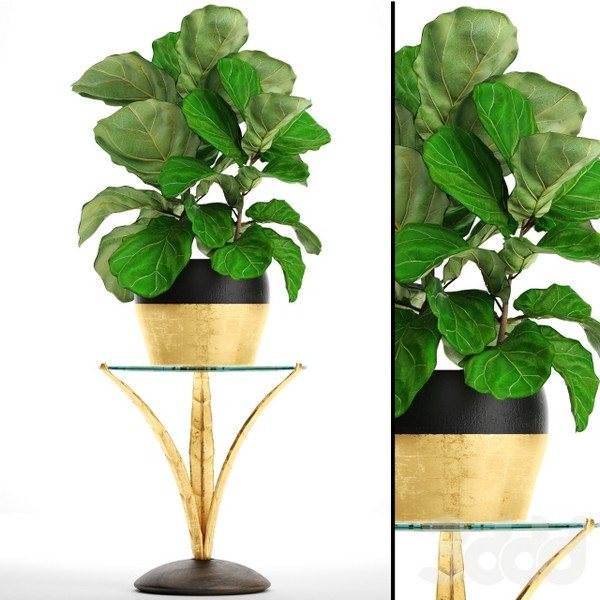

Lyre-shaped ficus differs from its other "counterparts" in a sufficiently impressive size
Ficus are the most popular "residents" of offices and apartments. They are excellent air filters. The sight of a lyre ficus can be simply mesmerizing. A long graceful stem is crowned with large dark green foliage on the outside, and on the inside - a lighter shade. Brightly presented veins are light green or mixed with yellow color.
Important! Of all the unpretentious representatives of ficuses, ficus lyrata makes the most claims to growing conditions.
The plant propagates by cuttings (this is considered a more efficient way). Ficus reacts to errors in leaving by dropping leaves or changing their color. Care problems can be associated with the fact that the plant is quite selective in the choice of fertilizer.
Ficus is a tasty morsel for most parasitic insects. They can be difficult to get rid of because the plant does not respond well to most fungicides. Also, pest control can be complicated by the special structure of the leaves and bark.
Interesting! The trunk is covered with a bark with a special relief, in which insects easily hide; the same goes for foliage.
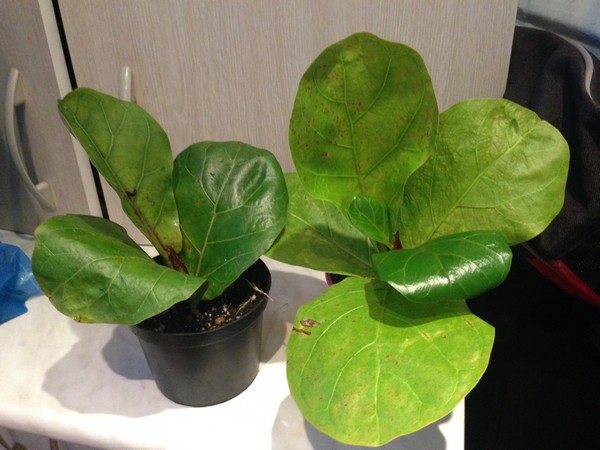

Fighting pests that attacked lyre ficus is not always easy, but still possible
You can save your "pet" from diseases and help him grow lush greenery by observing the growing rules that we have listed in the article. The basic rule is to create conditions for plant life that are close to natural. The homeland of ficus is the subtropics, which means that the plant needs to be provided with increased humidity, but not by increasing the number of watering. You can make the air more humid by frequent spraying and frequent wiping of the foliage with a damp cloth.
General information
In nature, the plant can be found in the African tropics. The initial stage of ficus life takes place in an epiphytic form. The lyre ficus is located in the tree crown of other plants and lowers its aerial root system to the soil, where the roots are successfully strengthened and, braiding the trunk of the host tree, quite often cause its death.
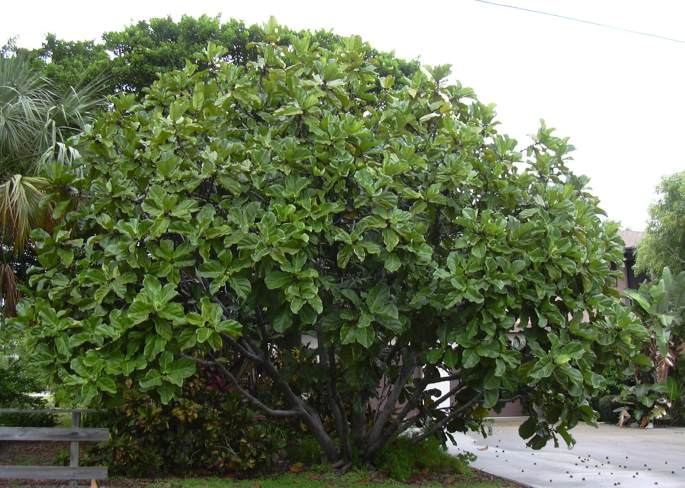

Ficus often grows as a free-standing tree, the height of which can reach 15 meters. Lyrate ficus has large leathery leaves that have a waxy bloom, wavy edges and an extension at the end. Exactly what in shape, the leaves of the tree resemble a lyre, and gave the name to this plant. The average length of the leaves can reach half a meter and be about 30 centimeters wide. Under natural conditions, green fruits with a diameter of no more than 3 centimeters are formed on a giant tree.
The following indoor varieties of lyre ficus are most popular with flower growers:
- high variant of the columnar plant of the "Columnaris" variety;
- compact variety "Bambino";
- medium-sized cultivar "Little Fiddle".
We also invite you to learn about the features of growing ficus Elastic.
Photo
In the photo, the ficus "Lirata":
Watering mode
Often the death of indoor "pets" is associated with a violation of the irrigation regime. Indoors, they tend to grow in small containers, where the air is very dry due to the running central heating. The roots are immersed in a small clod of earth, so irrigation errors can negatively affect the development of the flower.


It is important not to "flood" the flower - this can lead to its death
It is necessary to moisten the soil only when the top layer of the earth dries up. You can check soil moisture by immersing your finger 1 cm in the soil. If the ground is slightly damp above, then the plant can already be watered.
Attention! Excessive watering can cause the death of the ficus.
For irrigation, it is allowed to use water from the water supply.Before moistening the soil, the water must be allowed to settle so that the chlorine can escape from it. If possible, then the ficus should be sprayed and the air humidified. The foliage should be wiped off so that the dust layer does not interfere with photosynthesis. A warm shower is recommended every 1-2 months.


It is better to water the flower with settled water

